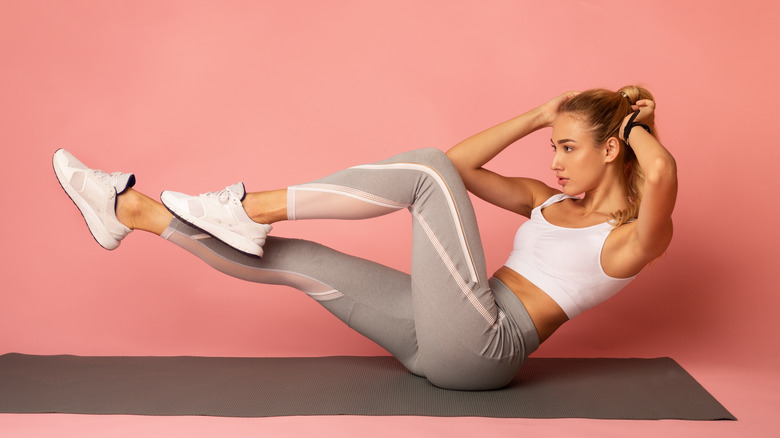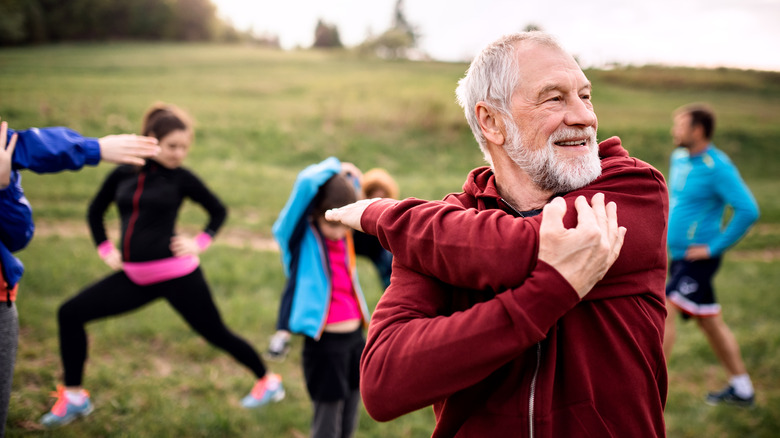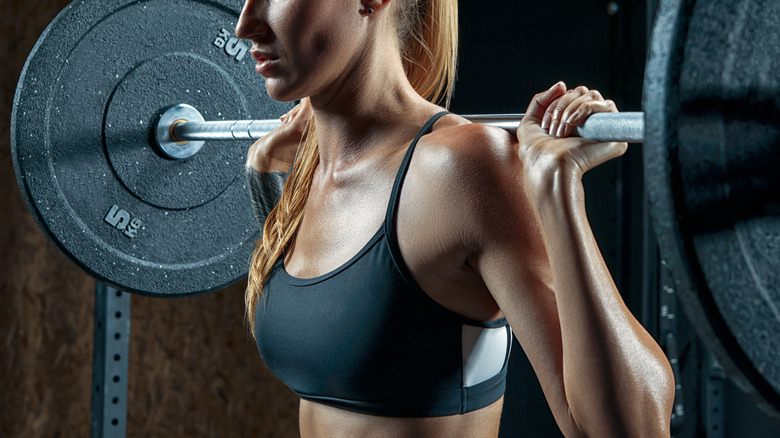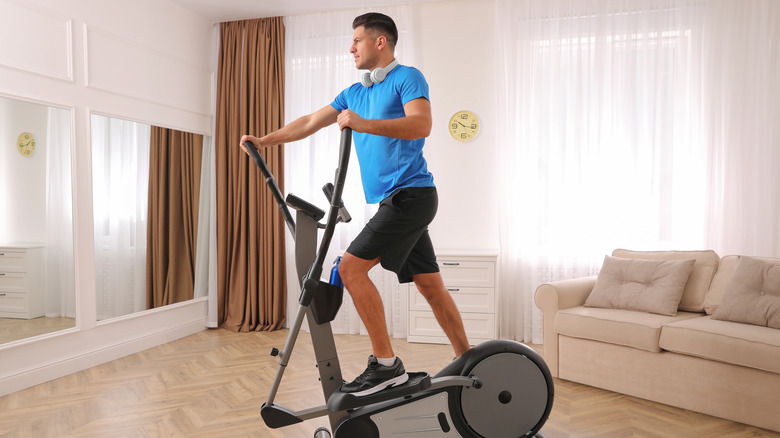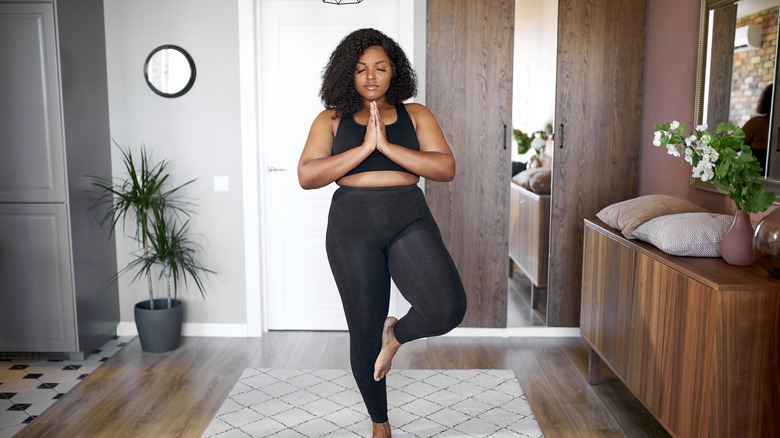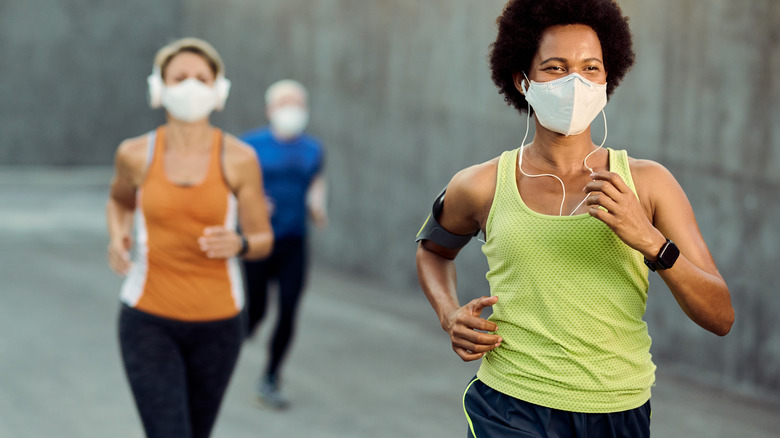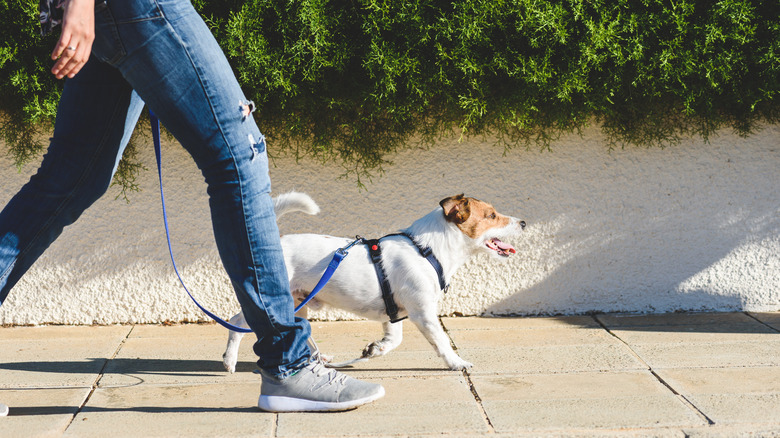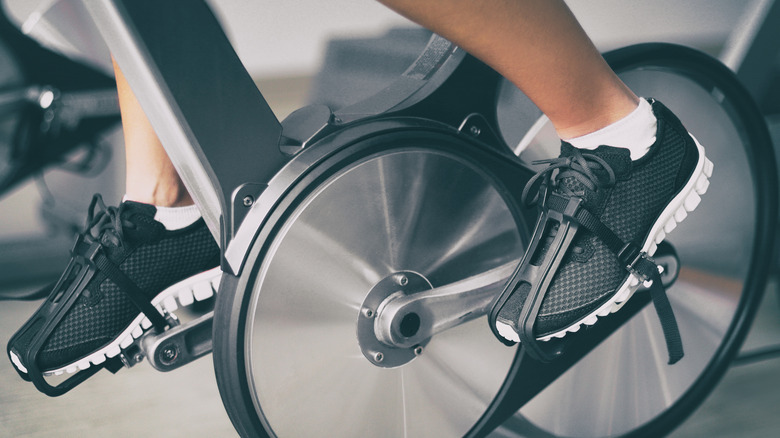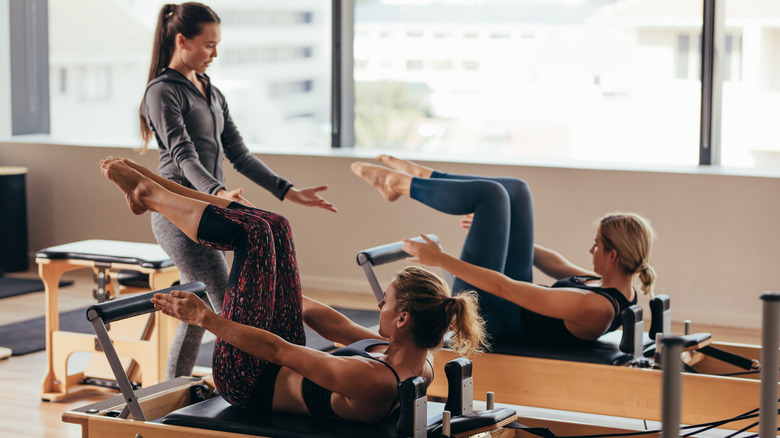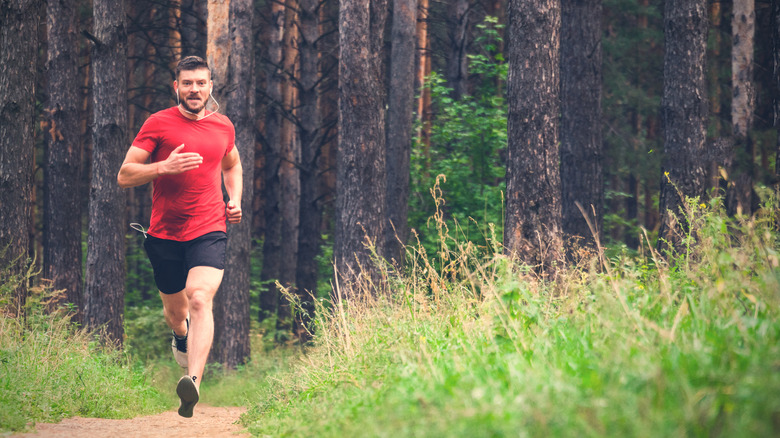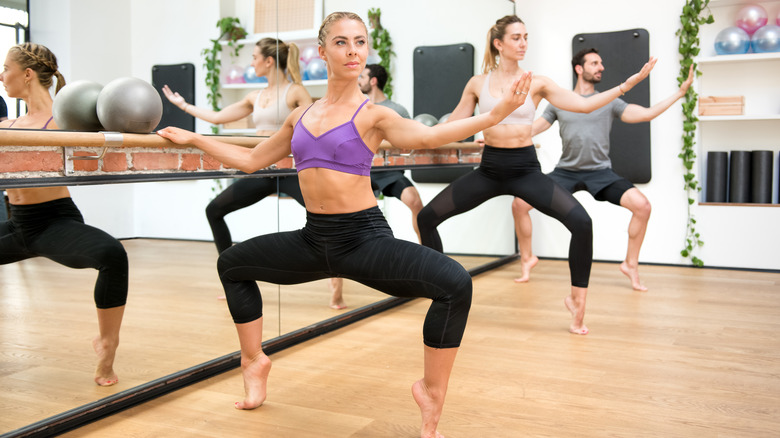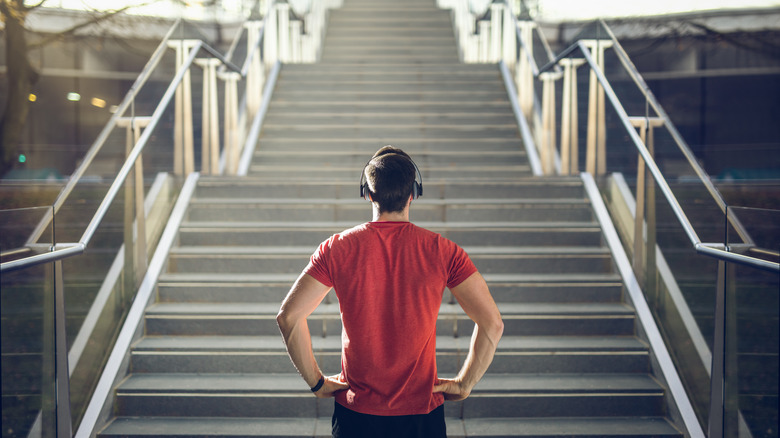Workouts That Don't Burn As Many Calories As You Think
These days, it feels like there are more choices when it comes to exercise than ever before. Between Zumba classes, park runs, spin workouts, hot yoga sessions, and YouTube fitness gurus offering HIIT blasts ... the choices are seemingly endless. And all of this has added up to a frankly colossal sum of money: the global fitness industry is, as of 2021, worth a jaw-dropping $87 billion, with the U.S. holding some of the highest numbers of fitness club memberships in the world, according to Policy Advice.
But with all that choice out there, we want to make sure we're getting proper bang for our hard-earned buck (or the limited time we have in the day) when we're working out. But what if the workout you're doing isn't as effective as you think? Somewhat surprisingly, so many of the workouts that we know and love are pretty inefficient when it comes to burning calories. And if that's your goal when it comes to exercise, you don't want to be wasting precious hours and dollars on a workout that'll leave you wanting more. Let's take a look at some of the top workouts that really don't burn as many calories as you think.
Your ab workout won't torch belly fat
A well-toned stomach is often seen as the pinnacle of good health (well, by advertising companies, anyway). But if you've been killing that ab workout for months and seeing little change to your overall weight, there could be a reason for that. Ab workouts simply don't burn that many calories (per US News). "People think that by working their abs, they're directly 'burning the fat' that sits on top of them," says LA-based certified strength and conditioning specialist and personal trainer Mike Donavanik to US News. "They're not."
The myth of "spot reducing" belly fat by doing ab exercises is a long-standing misconception that's been shown to be ineffective in many studies, according to Healthline. Instead, you need to combine your muscle-building ab exercises with workouts that'll give a high-calorie burn to reduce overall body fat. If you've been working hard on your abs, though, there's some good news: doing strength training to build muscle mass means that you'll end up burning more calories throughout the day, as muscle tissue naturally burns more calories than body fat, states WebMD. As the website points out, 10 pounds of muscle burns more than twice the number of calories as 10 pounds of body fat, even when resting.
Stretching is great for many things, but not calorie loss
Stretching is a highly important part of any exercise regime, and its benefits could be huge: amongst other things, stretching increases blood flow to the muscles, may reduce the risk of injury during exercise, and could improve your athletic performance, says the Mayo Clinic. One thing stretching won't do, however, is burn many calories. As Healthline points out, stretching alone burns merely 2.7 calories per minute on average, so a 10-minute stretching routine would only burn 27 calories. When you consider that we burn 50 calories an hour while we're sleeping (per the Sleep Foundation), it's hardly a big difference.
However, there are certain ways we can mix up a stretching routine to make it way more effective for burning calories, says personal trainer Ngo Okafor to Business Insider. "Fire up your stretch routine by adding cardio bursts between stretch positions," says Okafor. "You will still get the benefit of stretching with cardio bursts infused, which raises your heart rate and burns a ton of calories." To put this into practice, try throwing in some jumping jacks or jogging on the spot next time you're stretching.
Weightlifting alone won't burn huge calories
We've all seen those dudes in the gym grunting like their lives depend on it as they lift weights. It looks and sounds like they're firing through those calories, right? Well, unless they're really going for it, the likelihood is they won't be burning that many. Weightlifting, at a general level, will only burn 90-126 calories per half-hour session, according to Medical News Today. More vigorous weightlifting might burn more, between 180-252 calories for the same amount of time, depending on how much the person weighs.
However, while just weightlifting alone might not burn many calories per session, incorporating strength training or other anaerobic exercises – exercises which activate our fast-twitch muscles — into certain exercise plans can be an excellent way to burn calories, both during a workout and afterward (via WebMD). In fact, a HIIT workout that contains strength straining or weightlifting elements can actually end up burning more calories minute-for-minute than cardio exercises on their own, as Healthline points out. What's more, weightlifting is hugely beneficial for long-term calorie burn, since having more muscle means you burn more calories overall.
Elliptical machines overestimate your calories burned
There are few exercise machines more divisive than the elliptical. And if you're a staunch supporter (because let's be real, all that swinging is pretty fun), one thing that may change your mind it is the fact that elliptical workouts often aren't that beneficial on a calorie-burning front. In fact, that little counter on the elliptical telling you how many calories you've burned can be hugely inaccurate, leading us to overestimate how effective it is (per US News). "That's largely because the elliptical allows people to use too much momentum and bodyweight assistance," says LA-based certified strength and conditioning specialist and personal trainer Mike Donavanik to US News. "Once an individual's foot reaches the top of the movement, it's largely bodyweight that presses the foot down, and that momentum builds and just keeps going." As a result, says Donavanik, "It gives users a false sense of calories burned and work done." However, elliptical-lovers shouldn't fear: there are ways to supercharge your elliptical workout to make sure your calorie game is strong. Simple adjustments like adding an incline or mixing up your routine with dumbbell breaks, as SELF advises, are excellent ways to add additional resistance and make your workout more effective.
Yoga -- even hot yoga -- is low on calorie expenditure
Most people know that yoga's a gentle exercise that builds strength, endurance, and fitness over time. However, when it comes to the crunch, yoga isn't that effective as a calorie-burning exercise, says TIME. Even hot yoga may not burn as many calories as you'd think — according to TIME, a session of Bikram yoga will burn around the same number of calories as a brisk walk. As with any form of exercise, though, there are ways to adapt a yoga routine to accentuate calorie burn. Try and incorporate poses that engage the major muscle groups in more challenging ways, like chair pose, Chaturanga Dandasana, high lunges, and a good old plank, advises Prevention. Within these poses, variations can help you burn even more calories. For example, in a plank, "you can increase the calorie burn further with variations like raising one foot an inch or two off of the mat," says Mandy Ingber, celebrity yoga instructor and author of "Yogalosophy for Inner Strength," to Prevention.
When it comes to running, this might surprise you
Wait... what? Running, the holy grail of cardio, is not good for burning calories? Unfortunately, folks, this may be the case, although it all depends on how you run (per SELF). While running has huge benefits for heart health, in terms of calories, your body can quickly adjust to the demands of a regular running routine. "Your body is a machine, and it just wants to do things as efficiently as possible," says Rachele Pojednic, exercise physiology and nutrition expert, to SELF. When your body adapts, it learns to expend fewer calories per workout — meaning your daily run might have diminishing returns. In addition, that run you're going on isn't that efficient when it comes to calorie expenditure per time. "Relying on running alone isn't the best way to lose weight because it burns relatively few calories for the time invested," says Pojednic. Instead, if you want to get the most from your run, mix it up by challenging yourself. Taking a route that has more hills, adding resistance bands, or simply doing a few jumping exercises in your warmup are all easy ways to boost your calorie burn during a run, according to ASICS.
You'll need to do a lot of walking to burn calories
Fundamentally, walking is a low-intensity exercise, meaning that we elevate our heart rate to a much lower level than if we're working out harder, says Sweat. While this means that we can generally do these types of workouts for longer, it also means that we need to do them for longer if we want to see significant calorie expenditure (via Business Insider). In the case of walking, that means that you need to walk much for much longer periods and distances to get the same calorie burn that high-intensity activity would give in a shorter time. If you're a keen walker, though, you can do things to make your daily stroll more calorie-efficient. "Make your walks more intense by picking up the pace," recommends Trainerize.me personal trainer Ariana Fotinakis to Business Insider. "If it's too challenging to walk briskly for the entire duration of your walk, you can pick a couple of landmarks to walk briskly to (i.e. the sign at the end of the street, the big tree two blocks away, etc.)."
Spinning probably isn't as effective as you think
Okay, so we know this one might raise a few eyebrows ... but bear with us. Spinning is a perennial exercise class favorite, with people leaving on shaking legs, sure they've torched through their daily calories. The fact remains, though, that spinning can be pretty ineffective for burning calories due to the fact that it's a non-weight-bearing exercise, and it uses few muscles (per Business Insider). "You're sitting in a chair and not using any muscles except your legs. You don't get near the calorie burn you would using a regular bike," states spin trainer Cristy Nickel to Business Insider. Bumping up the difficulty of a spinning session by adding resistance or incorporating high-intensity interval training elements will add to your overall expenditure. Bear in mind, though, that stationary bikes can't tell what pedaling technique you're using, meaning that when you mix it up in a spin class by doing, for example, a standing climb, the calorie counter on the bike's display can end up being inaccurate (per Shape).
You can boost your Pilates routine's calorie burn
A Pilates class is an excellent way to exercise gently and has benefits for posture, flexibility, and building lean muscle, as Healthline points out. On the calorie burning front, however, Pilates is less effective. A low-intensity exercise, a regular Pilates mat class lasting around 50 minutes will burn around 175 calories for a person who weighs 150 pounds. This number gets slightly higher for more complicated Pilates workouts, with an advanced class of the same length burning just over 250 calories on average. But when you compare this to a HIIT class, for example, which can burn 450 calories in just 30 minutes (per Fitbod), it's clear how comparatively low the calorie expenditure can be in Pilates.
If you can't get enough of Pilates, though, mix up your routine by adding some calorie-boosting moves. Simple moves like swimming (lying on your stomach on the mat with arms and legs raised off the ground, and then further lifting and lowering the opposite arms and legs in an alternating pattern) and the crisscross (lying on your back with your hands behind your head and bringing each elbow to the alternate knee, like a bicycle crunch), can help to fire up your Pilates, increase resistance, and get your heart going, according to Women's Health Magazine.
Golf isn't exactly strenuous most of the time
Okay, so before anybody says anything: we know that you know that golf isn't hardcore exercise. But if we're classifying it as a sport (and we are), it's our duty to point out that it's a sport that doesn't burn many calories at all. "This is really more of a leisure activity than exercise," says spin trainer Cristy Nickel to Business Insider. One reason for golf's relative lack of calorie expenditure is that people are usually driving from hole to hole in a buggy. "These days it's hard to find a course that will let you walk rather than ride in a cart, but brisk walking between rounds will increase your calorie burn." If you can find a course that lets you walk as opposed to driving, however, your calorie burn could leap up quite considerably. This is especially true if you caddy for yourself. Carrying or pulling heavy golf clubs could see your calories burned per hour shoot up, according to Captain Calculator. Using a golf cart, however, will naturally mean you're burning significantly less.
Long-distance running can actually decrease your daily calorie burn
On the surface, long-distance running seems like an amazing way to burn calories: all of that activity over a long distance and time, and they must just melt away, right? Well when it comes to this workout, it can be pretty uneconomical when you look at time spent versus calories burned, according to LA-based certified strength and conditioning specialist and personal trainer Mike Donavanik (via US News). But more importantly, Donavanik points out to US News that long-distance running can often result in the body drawing on energy reserves from the protein in your muscle. This then burns muscle tissue, reducing your overall mass and strength over time, as well as meaning that you burn fewer calories overall (as more muscle = more calories used in a day). The solution? Get intense. "Your time and energy can be better spent doing high-intensity interval training [HIIT] like repeated sprints," Donavanik tells US News. "A smaller percentage of calories will come from fat but you'll burn more calories overall, including those burned from fat."
Calisthenics is hot right now -- but does it burn many calories?
People are going wild for calisthenics. A workout that uses "your own bodyweight as a means to maximize human power and athletic ability," according to military fitness instructor Tee Major (per Shape), the equipment- and hassle-free exercise form exploded in popularity during COVID when access to gyms was limited and online fitness instructors reigned supreme. In fact, Women's Fitness Magazine called calisthenics "the next big fitness trend" in 2020.
So with all this buzz, it's time to get wise to one simple fact: in comparison to other workouts, calisthenics won't burn as many calories as you think, unless you're hitting it hard. A regular calisthenics routine will, for a 200-pound person, burn roughly 200 calories per half hour, says WebMD. More intense routines, however, will boost the calorie expenditure (to a much higher 355 calories per half hour, for a 200-pound person again). To make your calisthenics routine more calorie efficient, make sure you're incorporating loads of exercises which use large muscle groups, like squats and lunges. Routines composed of these sorts of exercises, which test large portions of your body, will burn more calories than routines using smaller muscle groups, as School of Calisthenics points out.
Barre's after-effects make it worthwhile
Barre classes have become infamous, and one look at the physiques of ballet dancers should tell you all you need to know about their long-term effectiveness. However, don't be fooled: while barre will help you to improve your posture and strengthen muscles, your calorie spend during a workout is actually quite low. The average person weighing 150 pounds, for example, only stands to burn approximately 255 calories in a 55-minute class, according to Livestrong, while a more intense class might boost this slightly.
However, don't discount the fact that you may be burning calories long after the class. "A resistance workout (such as free weights or a barre class) may burn only 300 calories in the hour, but it can also cause a spike in a person's metabolic rate for the rest of the day," states Sari Eitches, an internist at Akasha Center for Integrative Medicine in Santa Monica, for Physique 57. "You will continue to burn more calories even as you rest and recover; that's part of the shaky muscle feeling that comes after a resistance workout." Eitches makes a valuable point that can apply to lots of different types of exercise: just because you're not spending loads of calories during the workout itself doesn't mean it's not going to be effective; and the after-effects of a barre class make them worth it.
Contrary to popular belief, pure cardio is not the best way to burn calories
"Okay, come on," we hear you cry, "now cardio's not effective for burning calories? Is there nothing left?!" Let us clarify: cardio is great for burning calories, but cardio alone is less efficient when it comes to calories for several reasons (via Verywell Fit). Ideally, cardio workouts should be combined with resistance or weight training to ensure optimal fat loss, as the after-burn effects of weight training, as well as the added calorie burn that comes from increased muscle mass, maximizes your overall calories used.
More to the point, weight training keeps your muscles strong and maintained when you're hitting the cardio. "The loss of muscle [with excessive cardio] destroys your metabolism," says founder of UX3 Nutrition and International Sports Science Association director John Rowley to Popsugar. "If you are going to do cardio, do it in conjunction with a well-thought-out weight training workout." And finally, one more reason why pure cardio might not be that effective: ever felt hungry after a run? "Cardio will help burn calories but can often make you hungry, leading to excessive calorie-consuming after workouts," says Rowley. Your cardio might torch through calories, but you'll lose the benefit if you replace them right afterward.


